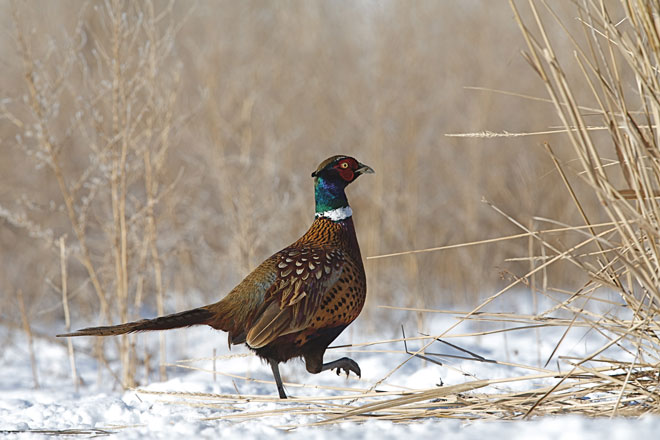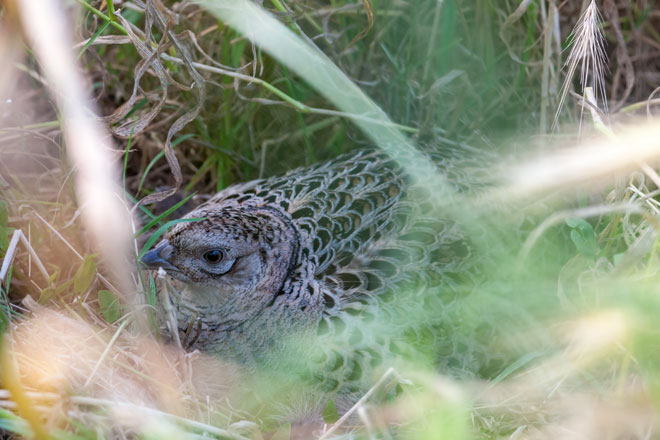Winter hit early and hard, but never count out the ring-necked pheasant
By Andrew Johnson
A brutal winter has taken its toll on bird populations across the primary pheasant range. But the stage could still be set to produce a bumper crop of birds this spring.
Winter came early and often to the Upper Midwest this year. The week before Christmas, temperatures plummeted to well below zero. Snowstorm after snowstorm blanketed the landscape, drifting in marginal cover and covering food sources with a foot or more of snow … and in some places, much more. Days of brutal weather stretched into weeks at times, reminding pheasants and pheasant hunters how unforgiving a prairie winter can be.
And while there were localized reports of pheasant mortality this winter, the fact remains that spring nesting and brood-rearing conditions ultimately have a more profound impact on bird production. With that in mind, there is hope on the horizon as we all look toward the spring nesting season. Here’s why.
Bad Weather Birds
For starters, a pheasant’s beauty is only surpassed by its toughness, and throughout what we all hope was winter’s worst weather, the resilience of pheasants was on full display.
“Pheasants and native game birds such as sharp-tailed grouse and prairie chickens are built for survival and can withstand freezing, subzero temperatures pretty well as long as they have some high-quality habitat around,” says Matt Morlock, Pheasant Forever’s state coordinator for both North and South Dakota. “The actual temperature isn’t necessarily a killer. What is a killer is the loss of a food source when it’s covered by snow and ice.”
As temperatures drop, the laws of nature dictate that pheasants and other wildlife must use more energy to stay warm. And to do that, they must dramatically increase their food consumption.
“It becomes much more challenging for the birds if the waste grain in agricultural fields is buried,” Morlock says. “Pheasants really rely on that grain, and digging and scratching for food costs them a lot of energy.”
 For starters, a pheasant’s beauty is only surpassed by its toughness.
For starters, a pheasant’s beauty is only surpassed by its toughness.
Each fall, pheasants begin preparing for winter by storing up energy in the form of fat reserves for critical situations when they’re forced to go a day or two — or sometimes longer — without food. A healthy pheasant can easily go several days without feeding, as long as it has thermal cover available. Once a bird has exhausted its fat reserves, however, things get tricky.
“Most birds can make it through the storms, but it turns into a big ordeal when food is covered for two months at a time,” Morlock says. “That’s when things start to go downhill in a hurry, so the little warmup we had here in February is definitely a good thing. If it would have stayed subzero for another week or two, we would’ve lost some more birds.”
Glass Half Full
The February warmup was almost like a light at the end of the tunnel, says Tanner Bruse, PF’s state coordinator in Minnesota.
“We’ve had a brutal winter — we didn’t need a prolonged winter,” Bruse says. “The recent sun and warmer temperatures opened up some ground and actually exposed some food and grit that’s been buried for a while, which definitely gave the birds a reprieve.”
“With all the snow we’ve had, people have still been seeing birds everywhere and started to realize how tough they are,” Bruse continues. “And now with this warmer weather, some of the doom and gloom surrounding bird populations from earlier this winter has eased a little bit.”
Many pheasant hunters latch on to localized reports of winter die-offs as a harbinger of what next fall’s huntable pheasant population will be. But Bruse is quick to point out that spring nesting conditions are typically far more important when it comes to bird production. That’s why he’s choosing to look at this spring with a glass-half-full mentality.
“I’m optimistic about the spring,” says Bruse. “There are still a lot of birds out there, and if we can get rid of the snow in a decent time and stay somewhat warm, that’ll lead to optimal nesting conditions.”
Drought conditions have been the norm across the plains states the past few years, so the added moisture from snowmelt should give spring nesting habitat a much-needed shot in the arm.
 There are still a lot of birds out there, and if we can get rid of the snow in a decent time and stay somewhat warm, that’ll lead to optimal nesting conditions.
There are still a lot of birds out there, and if we can get rid of the snow in a decent time and stay somewhat warm, that’ll lead to optimal nesting conditions.
“If the snow melts slowly it’ll recharge the soil and help nesting cover take off this spring, especially on grass or CRP and CREP acres that have been actively managed the last two years due to drought,” Morlock says. “Because those areas have been managed, they don’t have a thick litter layer or a lot of that duff, so that cover can really take off with the snow melt. Even places that weren’t managed are still going to react positively to that added moisture.”
Pheasants respond well to early successional habitat, and any time there’s management activity on grassland habitat — haying, grazing, burning — the new growth that emerges provides prime nesting and brood-rearing cover for pheasants.
“Whether it’s a new seeding or an area that’s been actively managed, that early successional habitat helps birds flourish for a couple reasons,” Bruse says. “First, that new flush of grasses and forbs attracts plenty of insects and provides a forage base for nesting hens. Plus, that new growth not only creates optimal nesting habitat, but it also provides ideal brood-rearing habitat that chicks can run around in that offers plenty of insects for food and a canopy for protection.”
The Big “If”
Both Morlock and Bruse admit pheasant populations took a hit already this winter. At the same time, however, they believe pheasant numbers were in pretty good shape last fall.
“The positive is we had a lot of birds coming into the winter, so we were at a better starting point than the past few years,” says Morlock, who has also started to hear anecdotal reports trickle in from the field that more birds survived the worst part of winter than first expected. “If good nesting cover is available, pheasants can pull off a good hatch, and looking at the current long-term weather forecast, we’re set up for a pretty good spring.”
Bruse agrees, saying what he’s been telling everybody is that if a few key weather factors fall into place, bird numbers this fall should be close to last year’s numbers in many parts of the pheasant range.
One weather-related factor that could potentially hamper production would be if the snow melts all at once, creating a really quick run-off, and/or if flooding occurs. Conversely, if drought returns early and nesting habitat dries up right away, that could also limit nesting success. And last, if the peak hatch period during June is either cold and wet or extremely hot and dry, then bird production would likely take a turn for the worse.
“In layman’s terms, how many birds we’ll have this fall boils down to good spring weather and nesting/brood-rearing habitat,” Bruse concludes. “We can’t control the weather, so that’s why we focus on the habitat. And if we have a decent spring where nothing crazy happens weather-wise, bird numbers should bounce back from any winter mortality we had pretty quick.”
Winter isn’t over. But recent reprieves have been good for the birds. Pheasants are tough: When it comes to the ringneck, never lose hope.
South Dakota’s Andrew Johnson reports on a wide variety of conservation, hunting and pheasant-related topics for The Habitat Organization.